
Stanford Innovation Survey: Creation of Non-profit Organizations

Stanford alumni, faculty and staff engage in many different types of innovation. These are early results from the Stanford Innovation Survey, and I would be grateful for help in catching any errors, suggestions on further analysis, or feedback on what would be most interesting. Over the next several weeks, I will go through some initial results and analysis of various types of innovation and entrepreneurship that we gathered in the survey on the Stanford Innovation Survey website.
One type of innovation that Stanford is famous for is creating new organizations. In recent years, I’ve noticed a trend in my classes towards increased interest in the creation of non-profit organizations. So I wanted to see if we picked up this trend in the data and how many non-profits Stanford alumni were creating.
In the survey, 2,365 individuals reported having founded at least one non-profit organization in their careers. Similar to the phenomenon of serial entrepreneurship, it turns out that many of these alumni have created multiple non-profits. Respondents indicated having founded a total of 6,432 non-profit organizations. If we extrapolate that up, based on the response rate, Stanford alumni, faculty and staff have created over 30,000 non-profit organizations over the decades! Of course, not all of these survive, but that’s quite an impact.
The first figure shows the total number of new organizations (including angel investments, early employee positions and Board of Directors positions) for the respondents.
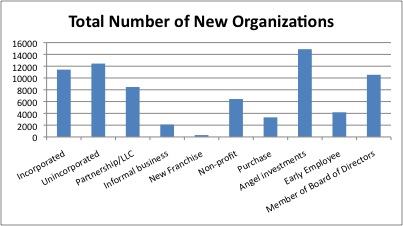
We also asked what general field the non-profit was operating in. By far the most common type of non-profit created is related to Education. The second most frequent response was Arts/Culture/Recreation followed by Global Health or Healthcare related. Consumer Rights non-profits were the least common.
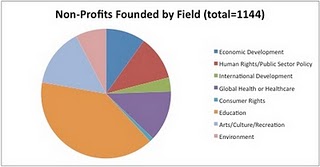
Next, we turn to the graduation year of the non-profit founder. Here we find that the creation of non-profits peaks with graduates from the 1960s and 1970s. We might expect that the downward curve is due to the fact that graduates from more recent decades may plan to start non-profits in the future or in a more advanced stage of their careers, but have not had time yet.
Interestingly, confirming the trends I have noticed in classes, we do see a big bump upwards in the rate of non-profit creation among students who graduated very recently (in the 2000s). We should also plot these by the year that the non-profit was founded to see if there are similar trends there.
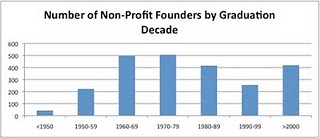
Talking with a few alumni who had engaged in both for-profit and not-for-profit entrepreneurship, I was also curious how many of these non-profit founders had also started for-profit businesses. We see that many of them have founded for-profit businesses as well. In particular, many of those who had founded an incorporated business or been a Board of Directors member had also founded a non-profit organization (either before or afterwards).
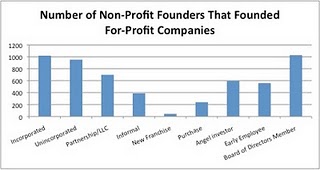
The final figure shows the proportion of Stanford alumni, faculty and staff who created a for-profit company vs. a non-profit company. While non-profit entrepreneurship has been growing over time, it is still a relatively smaller percentage compared with the number who engage in for-profit entrepreneurship and innovation.
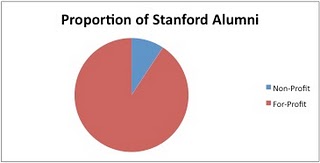
Visit the Stanford Innovation Survey website and let me know if you have comments or further suggestions. We plan to continue this analysis with the next step being to examine the schools and departments that have most frequently produced non-profit founders and whether there have been changes in those patterns over time.


